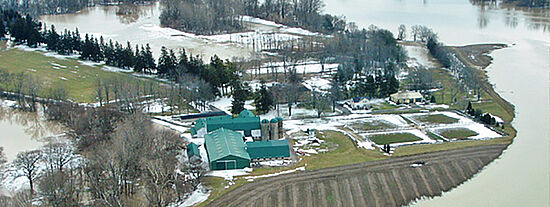The escalating economic cost of flooding in Ontario is getting the attention of the financial sector.
Earlier this month, the Canadian Investment Review (CIR) focused on a report published late last year by the University of Waterloo’s Intact Centre on Climate Adaptation. The report provided results of a survey of all the provinces and one territory (Yukon) to gauge their flood preparedness and flood risk mitigation activities. And what they found was disappointing – the average grade is C-.
So why is this investment organization – comprised of many of Canada’s leading university and business financial experts – interested in flooding? It’s because of the growing impacts of flooding which pose a risk to pension funds.
Pension portfolios typically carry real estate and infrastructure assets, energy stocks and municipal bonds according to the article published by CIR. All can be adversely affected by the physical damages of flooding and the escalating economic impacts which are associated with catastrophic events.
In the report, Ontario got a B+ which surprisingly put us at the top of the class. Conservation Authorities have been on frontlines of flood risk mitigation and management for years and this grade highlights the clever decision made by the Province and Ontario’s municipalities many years ago.
When Conservation Authorities were beginning to be established during the 1940s, Ontario was dealing with some very significant soil erosion and flooding problems as a result of a variety of land management practices that included development in the floodplain and deforestation. Fortunately, a number of smart conservationists and water managers came up with a good idea – they would set up Conservation Authorities as local natural resource management agencies and their watershed-based approach would restore Ontario’s environment and prevent costly flooding and erosion. Recognizing both the local and provincial benefits of Conservation Authority programs, it was decided they would be jointly funded by municipalities and the Province on a 50-50 basis. Since 1946, 36 Conservation Authorities have been established.
This created a firm foundation for flood management in Ontario – it was properly funded, shared between local and provincial governments and it supported a watershed-based approach to flood management in Ontario.
For a period of time in the 1950s, 1960s and then specifically in the 1970s through the 1990s, under the Flood Damage Reduction Program, provincial and municipal support was leveraged by the federal government. These funding arrangements supported activities like flood plain mapping, flood infrastructure (dams and dikes), the development of planning and zoning policies, flood forecast and warning systems and the acquisition of floodplain lands.
In the 1990s, the Province dropped out of the funding arrangement and today provides only a small amount for flood management and infrastructure ($7.4 million per year to be divided up by all 36 Conservation Authorities for flood operations and an additional pot of $5 million per year which is matched by municipal funding for a limited number of flood infrastructure projects).
Municipalities have tried to fill the gap as best they could, however, the smaller tax base experienced by small rural and northern municipalities makes this tough. And it’s not easy for urban municipalities with large populations, either. They are dealing with the increasing complexities of aging flood and stormwater infrastructure compounded by a lack of natural assets like woodlands, wetlands and other natural features that help to mitigate impacts of heavy and intense rain and melting snow. A properly funded flood program has been estimated by Conservation Ontario to cost a total of $63.5 million per year.
The long standing Conservation Authority flood management and, broader watershed management programs have served Ontario well and contributed greatly to the B+ mark that we received as a province. But there are cracks in parts of the foundation and they’re getting larger as a result of climate change.
It’s a challenge to keep up with the escalating impacts of climate change. While Conservation Authorities still continue to protect people and property quite effectively, working with their municipal, provincial and federal partners, some of their flood management services and flood infrastructure assets are showing their age and suffer from a lack of consistent, adequate funding.
We are beginning to see some investment from the Federal Government under programs like the National Disaster Mitigation Program. However, in Ontario if we want to continue to prevent the escalating economic and social costs of flooding flagged in the Canadian Investment Review article, then a new business arrangement is needed around flood management programs, acknowledging that all stakeholders have a shared responsibility to reduce their flood risk.
One last message to remember is that investing in flood prevention is good business because it saves money. Public Safety Canada calculates that every dollar investigated in mitigation saves $3 - $5 in recovery costs. That’s a persuasive argument for all flood management partners and the general public, to consider when deciding how to improve Ontario’s flood management programs.
Authors: Jo-Anne Rzadki, Business and Partnership Coordinator, Conservation Ontario and Jane Lewington, Marketing and Communications Specialist, Conservation Ontario
